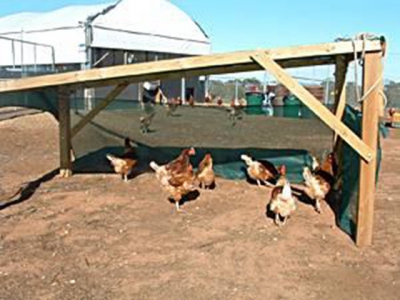Enriching free range chickens and reducing feather pecking

Studies by Australia’s Poultry CRC have looked at whether encouraging birds into the range leads to less feather pecking
An Australian research project has examined how greater provision of pasture, shaded areas and shelter belts can attract birds into the free range, following recommendations from a Poultry Cooperative Research Centres (CRC) project that explored enrichment strategies under Australian free range conditions. The use of repellents to suppress sporadic feather pecking was also explored.
The welfare of beak trimmed birds and the potential negative long-term effects of the procedure are becoming increasingly recognized by consumers. In modern pullet and layer houses it is possible to minimize the light intensity within the house and reduce the risk of outbreaks of injurious feather pecking. However, in barn and free-range systems the problem of feather pecking and cannibalism will persist, and alternatives to beak trimming were investigated by the study.
While pecking is a natural means by which poultry investigate their surroundings and establish a stable social order, the behaviour can escalate to the stage where brids will peck each other to death.
This cannibalism is a behaviourable problem that often develops into a vice that will persist and spread within a flock as a learned behaviour, even after the initial causes of the behaviour have been corrected. All forms of commercial poultry can experience cannibalism.
Research carried out in Europe has suggested that feather pecking in free range flocks is greatest when a low percentage of the flock uses the outside range, therefore, decreasing the stocking density within the house should be beneficial in reducing pecking.
Lack of security
Infrequent and uneven use of the hen run is one of the main problems in all free range systems for laying hens. Birds do not feel safe in a non-roofed run area. When a range has cover, trees or hedges, however, birds are more evenly distributed and the risk of feather pecking is reduced.
The CRC project revealed that only 9% of birds on free range farms use the range area. Factors found to influence range use include the weather, the season, the time of day, shade and variety of overhead structures, as well as the age of a bird and the size of a flock.
The CRC project looked at the design of facilities and products that may deter pecking under local conditions. The objective was to reduce the need for beak trimming and re-trimming by: developing design principles for free-range systems that minimize cannibalism; developing products that deter the onset of cannibalism and feather pecking; and, evaluating if light control during rearing and laying periods in modern poultry houses reduces the need for beak trimming.
The Poultry CRC project involved researchers at the South Australian Research and Development Institute (SARDI), the University of New England (UNE) and Queensland Primary Industries (DEEDI). Trials under free range conditions were conducted in South Australia, Queensland and New South Wales.
To encourage birds into the range, it needed to be enriched, offering more than simply open space.
Environmental enrichment increases desirable behaviours, reduces harmful ones, sustains the birds’ long term interest, and enables them to cope with challenges. Enrichment involves increasing environmental complexity to encourage birds to interact with their environment.
Natural behaviours
Project leader, SARDI’s Phil Glatz, explained that the main benefit of enrichment is that it gets birds out of the shed to engage in a wide range of natural behaviours. Trials at SARDI examined the role of shaded areas, the role of forage and the influence of shelter belts in the range. One trail suggested that forage availability has an impact on the percentage of birds using the range during the day.
Dr Glatz commented: “There is the perception that birds on free range farms in Australia are free to range but hardly ever go outside.
“This work has shown that birds will utilize the free range when the environment is enriched and, hence, their behavioural repertoire is enhanced. From an industry point of view, however, the health risks to birds increase when they make greater use of the range, due to increased exposure to wild birds, and other factors.”
The Queensland trials, conducted by DEEDI’s poultry extension officer, Tanya Nagle, showed that on commercial free range farms, the addition of shadecloth shelters, shelterbelts and forage to the range area did attract more hens to utilize the area.
Lloyd Thomson, commecial manager at CRC commented: "The trick with free range is to provide the birds with an environment that encourages them to make full use of the range, and therefore reduce feather pecking behaviours, while not creating a 'jungle" in which the birds will lay making collection of their eggs economically unviable."
Trials at UNE conducted by Associate Professor Geoff Hinch suggest that initial exposure of chicks to repellents may be associated with a reduced incidence of cannibalism and could provide another option in a multiple strategy approach to reducing potential cannibalism in layers.
Có thể bạn quan tâm
Phần mềm

Phối trộn thức ăn chăn nuôi

Pha dung dịch thủy canh

Định mức cho tôm ăn

Phối trộn phân bón NPK

Xác định tỷ lệ tôm sống

Chuyển đổi đơn vị phân bón

Xác định công suất sục khí

Chuyển đổi đơn vị tôm

Tính diện tích nhà kính

Tính thể tích ao hồ




 Nutrition, feeding issues impact broiler breeder feathering
Nutrition, feeding issues impact broiler breeder feathering  Sydney study links feed factors to feather pecking
Sydney study links feed factors to feather pecking